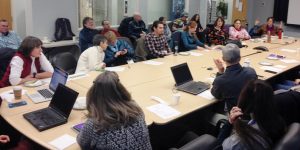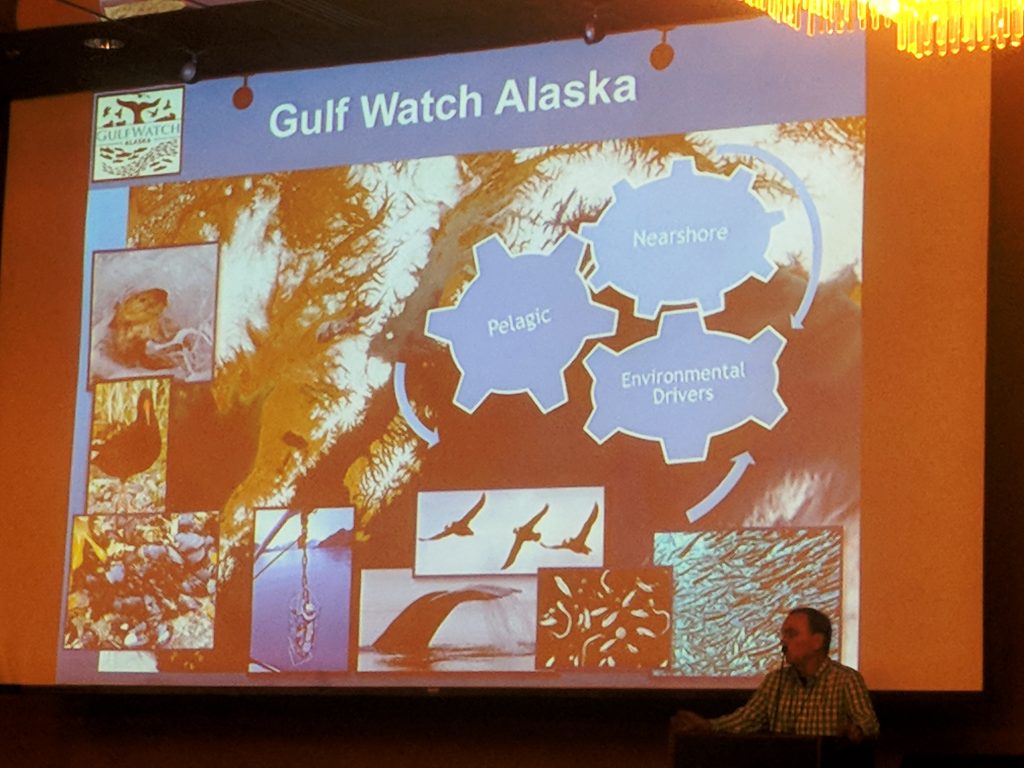The Gulf Watch Alaska program participated from January 22-26 in the 2018 Alaska Marine Science Symposium in Anchorage, Alaska. The symposium is Alaska’s premier marine research conference, bringing together over 700 scientists, educators, resource managers, students, and interested public to discuss the latest marine research being conducted in Alaskan waters. Each day of the conference highlights important Alaskan marine ecosystems, including the Gulf of Alaska session on January 23 that featured many Gulf Watch Alaska talks. The Alaska Marine Science Symposium uniquely convenes all presentations during one combined plenary session (as opposed to split sessions) to maximize the sharing of information with the entire audience.
Researchers from the Gulf Watch Alaska program were authors of five oral presentations and 17 posters featured in two different sessions. Presentations covered climate and oceanography, ecosystem perspectives, lower trophic levels, and new discoveries about the biology of plankton, infauna, fish, birds, and mammals. Highlighted were reviews by Gulf Watch Alaska researchers about the impacts of the recent 3-year North Pacific ocean “heat wave,” 25 years of Exxon Valdez oil spill experience, newly discovered ecosystem connections, human/resource connections, and many other subjects of direct relevance to response and restoration in Prince William Sound and the Gulf of Alaska.

Gulf Watch Alaska was featured in 17 posters at the Alaska Marine Science Symposium poster sessions on January 22 and 23 (photo credit: NOAA).
The following talks were presented by Gulf Watch Alaska researchers. A list of all the Gulf Watch Alaska presentations and posters can be found here.
-
- A profiling observatory for high resolution oceanographic, biogeochemical, and plankton observations in Prince William Sound. Robert Campbell, Prince William Sound Science Center.
- Ecosystem variability in lower Cook Inlet across trophic levels, space, seasons, and climate regimes, Martin Renner, Tern Again Consulting.
- Detecting and inferring cause of change in Alaska nearshore marine ecosystem: An approach using sea otters as a component of the nearshore benthic food web. James Bodkin, U.S. Geological Survey.
- Changes in forage fish during the winter 2015-16 seabird die-off and the North Pacific marine heat wave. Mayumi Arimitsu, U.S. Geological Survey.
- Unprecedented scale of seabird mortality in the NE Pacific during the 2015-2016 marine heatwave. William Sydeman (on behalf of John Piatt), U.S. Geological Survey.
Throughout the symposium, the Gulf Watch Alaska program also engaged in separate discussions with Alaskan colleagues on current and planned research and monitoring activities. Additionally, a program-wide meeting was held on January 23 as an opportunity to coordinate on program activities, share research updates, and plan annual activities.

The Gulf Watch Alaska program convenes in a special one-hour session at the Alaska Marine Science Symposium to coordinate on program activities and share recent research and monitoring updates (Photo credit: Stacey Buckelew).




